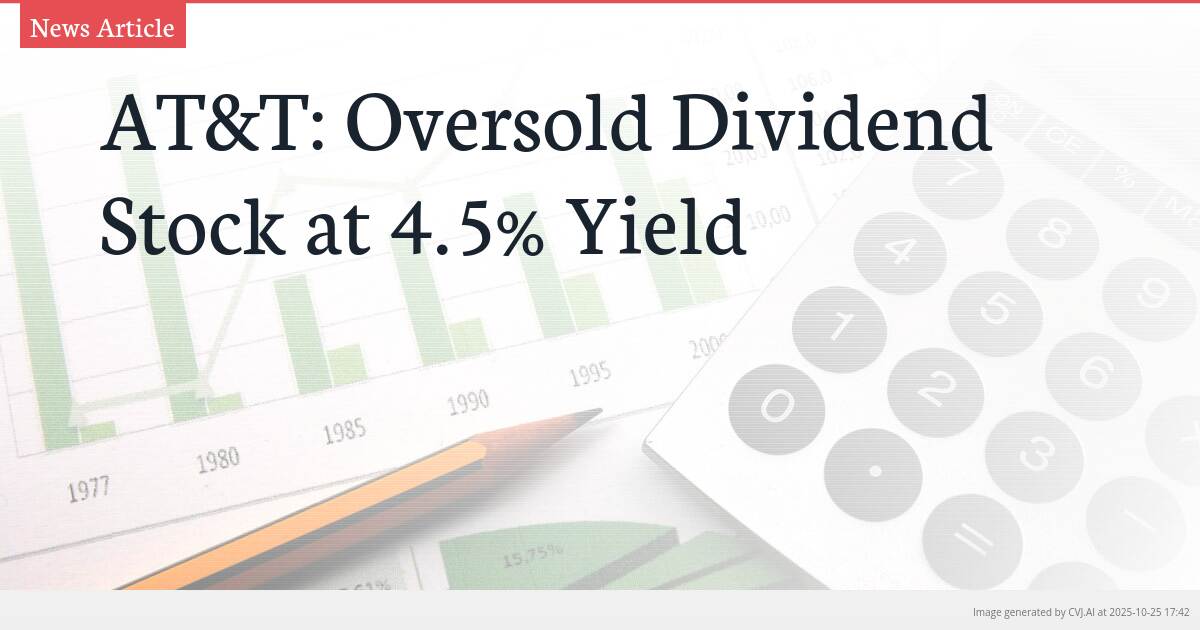This summary text is fully AI-generated and may therefore contain errors or be incomplete.
Introduction
AT&T stock has become oversold following disappointing quarterly results, creating a potential buying opportunity for dividend investors. With a P/E ratio of 8 and a swelling 4.5% dividend yield, the telecom giant offers attractive income potential for those seeking less correlation to the broader market, despite recent selling pressure that has pushed shares down 17% from 52-week highs.
Key Points
- AT&T shares have fallen 17% from 52-week highs despite the company operating at higher levels than its 2023 lows around $14 per share
- The company plans to spend approximately $22 billion this year while integrating recent acquisitions to improve network quality and competitiveness
- Long-term demand for low-latency, high-bandwidth wireless connectivity represents a significant growth opportunity for the telecom sector
The Oversold Opportunity in AT&T
AT&T shares have experienced a significant 17% plunge from recent 52-week highs, creating what appears to be an oversold condition in the market. This sell-off comes despite the company operating at substantially higher levels than its 2023 lows around $14 per share, representing a 75% recovery from those depths. The current valuation metrics present a compelling case for value investors, with the stock trading at just 8 times earnings and below the $25 per share threshold.
The recent quarterly results, while disappointing to some investors, have been met with what many analysts consider an excessive market reaction. The pressure on profitability numbers stems from intense competition in the telecom sector, a factor that CEO John Stankey and his team have been navigating throughout the company’s transformation journey. Despite these challenges, the fundamental improvement from AT&T’s 2023 position suggests the current sell-off may be overdone.
Dividend Appeal in a Volatile Market
As AT&T’s share price has declined, the dividend yield has swelled to approximately 4.5%, creating an attractive income opportunity for investors seeking yield in a market where many traditional dividend stocks trade at premium valuations. This inverse relationship between share price and yield actually decreases risk for income-focused investors, particularly when the underlying company’s turnaround plan remains on track.
The current yield level positions AT&T as a compelling alternative to S&P 500 components for investors looking for portfolio diversification and reduced correlation to broader market movements. For those comfortable with what the market describes as ‘bottom-fishing’ or ‘catching falling knives,’ the combination of high yield and turnaround potential presents a unique opportunity, though it requires patience and careful monitoring of the company’s financial health.
Investors should pay particular attention to the security of the dividend, especially given the company’s substantial capital expenditure plans. However, the current yield below 6% suggests market confidence in the dividend’s sustainability, unlike some higher-yielding stocks where yields north of 6% often signal dividend risk.
Strategic Investments and Long-Term Vision
AT&T’s aggressive investment strategy, including planned expenditures of approximately $22 billion this year and the integration of recent spectrum acquisitions, forms the foundation of CEO John Stankey’s confidence in the company’s trajectory. While these substantial investments may create near-term margin pressure and ‘bumpier’ financial results, they represent strategic bets on improving network quality and competitive positioning.
The company’s focus on enhancing value proposition—specifically delivering quality network performance for the price—aims to reclaim competitive edge in the wireless market. Though aggressive promotions and hefty capital spending will inevitably impact short-term profitability, the potential for market share gains could position AT&T for stronger performance as these investments mature.
Longer-term demand drivers, particularly the growing need for low-latency, high-bandwidth wireless connectivity, represent a significant growth opportunity for the entire telecom sector. As Stankey maintains his ‘really confident’ outlook, investors collecting the well-covered dividend during this transition period may be positioning themselves for both income and potential capital appreciation as AT&T’s strategic initiatives bear fruit.
📎 Read the original article on 247wallst.com

